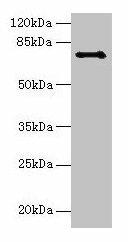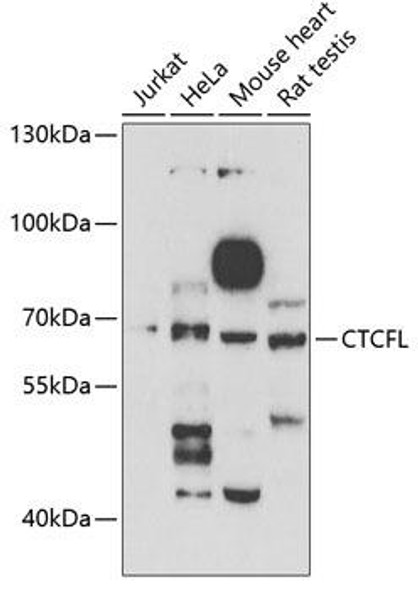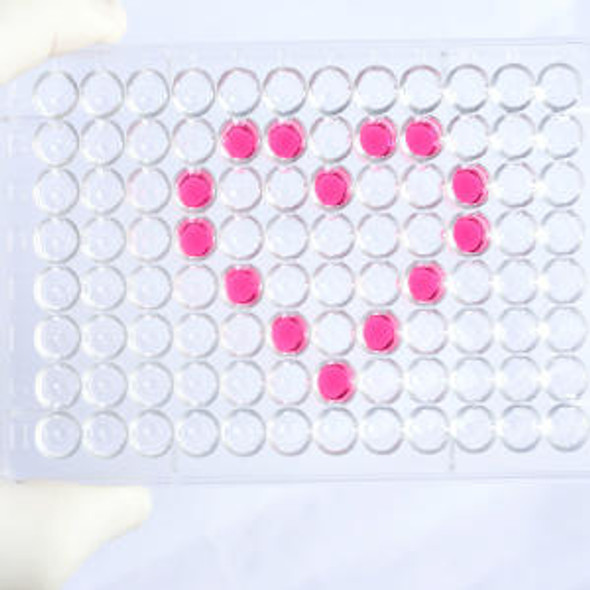Description
Ctcfl Antibody (PACO26009)
The CTCFL Polyclonal Antibody (PAC026009) is a valuable tool for researchers studying CTCFL, a transcription factor involved in epigenetic regulation and gene expression. This antibody, raised in rabbits, exhibits high reactivity with human samples and has been validated for use in various applications, including Western blot and immunohistochemistry.CTCFL, also known as CTCF-like protein, plays a critical role in chromatin organization and gene regulation, making it a key player in developmental processes and disease pathogenesis.
Its involvement in epigenetic mechanisms and gene silencing suggests its potential as a therapeutic target for diseases such as cancer and genetic disorders.By using the CTCFL Polyclonal Antibody, researchers can effectively detect and analyze CTCFL expression in different cell types, providing valuable insights into its function and potential implications in various biological processes. This antibody is a valuable tool for advancing research in epigenetics, gene regulation, and disease mechanisms.
| Antibody Name: | Ctcfl Antibody (PACO26009) |
| Antibody SKU: | PACO26009 |
| Size: | 50ug |
| Host Species: | Rabbit |
| Tested Applications: | ELISA, WB |
| Recommended Dilutions: | ELISA:1:2000-1:10000, WB:1:500-1:2000 |
| Species Reactivity: | Mouse, Human |
| Immunogen: | Recombinant Mouse Transcriptional repressor CTCFL protein (1-636AA) |
| Form: | Liquid |
| Storage Buffer: | Preservative: 0.03% Proclin 300 Constituents: 50% Glycerol, 0.01M PBS, PH 7.4 |
| Purification Method: | >95%, Protein G purified |
| Clonality: | Polyclonal |
| Isotype: | IgG |
| Conjugate: | Non-conjugated |
 | Western blot All lanes: Ctcfl antibody at 6µg/ml + Hela whole cell lysate Secondary Goat polyclonal to rabbit IgG at 1/10000 dilution Predicted band size: 74, 75 kDa Observed band size: 74 kDa . |
| Background: | Testis-specific DNA binding protein responsible for insulator function, nuclear architecture and transcriptional control, which probably acts by recruiting epigenetic chromatin modifiers. Plays a key role in gene imprinting in male germline, by participating in the establishment of differential methylation at the IGF2/H19 imprinted control region (ICR). Directly binds the unmethylated H19 ICR and recruits the PRMT7 methyltransferase, leading to methylate histone H4 'Arg-3' to form H4R3sme2. This probably leads to recruit de novo DNA methyltransferases at these sites. Seems to act as tumor suppressor. In association with DNMT1 and DNMT3B, involved in activation of BAG1 gene expression by binding to its promoter. Required for dimethylation of H3 lysine 4 (H3K4me2) of MYC and BRCA1 promoters. |
| Synonyms: | Transcriptional repressor CTCFL (Brother of the regulator of imprinted sites) (CCCTC-binding factor) (CTCF paralog) (CTCF-like protein), Ctcfl, Boris |
| UniProt Protein Function: | BORIS: Testis-specific DNA binding protein responsible for insulator function, nuclear architecture and transcriptional control, which probably acts by recruiting epigenetic chromatin modifiers. Plays a key role in gene imprinting in male germline, by participating in the establishment of differential methylation at the IGF2/H19 imprinted control region (ICR). Directly binds the unmethylated H19 ICR and recruits the PRMT7 methyltransferase, leading to methylate histone H4 'Arg-3' to form H4R3sme2. This probably leads to recruit de novo DNA methyltransferases at these sites. Seems to act as tumor suppressor. In association with DNMT1 and DNMT3B, involved in activation of BAG1 gene expression by binding to its promoter. Required for dimethylation of H3 lysine 4 (H3K4me2) of MYC and BRCA1 promoters. Interacts with histones, PRMT7 and SETD1A. Interacts (via N-terminus) with BAG6/BAT3. Testis specific. Specifically expressed in primary spermatocytes. Belongs to the CTCF zinc-finger protein family.Protein type: Cancer Testis Antigen (CTA); C2H2-type zinc finger protein; DNA-bindingCellular Component: cytoplasm; nucleusMolecular Function: DNA binding; histone binding; metal ion binding; nucleic acid binding; protein binding; sequence-specific DNA bindingBiological Process: chromatin modification; DNA methylation during gametogenesis; genetic imprinting; histone methylation; positive regulation of transcription from RNA polymerase II promoter; positive regulation of transcription, DNA-dependent; regulation of histone H3-K4 methylation; regulation of transcription, DNA-dependent; transcription from RNA polymerase II promoter; transcription, DNA-dependent |
| UniProt Protein Details: | |
| NCBI Summary: | |
| UniProt Code: | A2APF3 |
| NCBI GenInfo Identifier: | 124487069 |
| NCBI Gene ID: | 664799 |
| NCBI Accession: | NP_001074856.1 |
| UniProt Secondary Accession: | A2APF3,Q3Y6S0, B9EKP6 |
| UniProt Related Accession: | A2APF3 |
| Molecular Weight: | 75.1 kDa |
| NCBI Full Name: | transcriptional repressor CTCFL |
| NCBI Synonym Full Names: | CCCTC-binding factor (zinc finger protein)-like |
| NCBI Official Symbol: | Ctcfl |
| NCBI Official Synonym Symbols: | Boris; OTTMUSG00000016680 |
| NCBI Protein Information: | transcriptional repressor CTCFL |
| UniProt Protein Name: | Transcriptional repressor CTCFL |
| UniProt Synonym Protein Names: | Brother of the regulator of imprinted sites; CCCTC-binding factor; CTCF paralog; CTCF-like protein |
| Protein Family: | Transcriptional repressor |
| UniProt Gene Name: | Ctcfl |
| UniProt Entry Name: | CTCFL_MOUSE |










